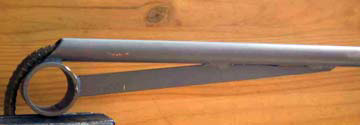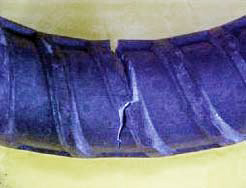Practice Advisory 1: Bend the bar but not the rules
Bending of steel reinforcement must follow New Zealand Standard procedures.
This information was confirmed as current in December 2016.
This Practice Advisory is issued as guidance information in accordance with section 175 of the Building Act 2004 and, if used, does not relieve any person of the obligation to consider any matter to which the information relates according to the circumstances of the particular case. This document is not a compliance document in terms of the Act and not a substitute for professional advice.
Issue of concern
Incorrect bending can severely affect the performance of steel reinforcement in service. Results can be premature fracture, which will affect the capacity of the building elements to carry design loads. Of particular concern is the practice of bending reinforcing steel to too small a diameter. Bending then straightening (rebending) the reinforcing on site is of even greater concern.
To avoid fracture or weakening, NZS 3109 requires that hooks and bends are formed in accordance with the bend requirements of Table 3.1, which is reproduced below with the permission of Standards New Zealand. The minimum diameter of bend is measured on the inside of the bar.
| Grade fy(Mpa) | Bar type | Bar diameter, db (mm) | Minimum diameter of bend, di (mm) | |
| 300 or 500 | Stirrups and ties | 6-20 | 2db | 4db |
| 24 | 3db | 6db | ||
| All other bars | 6-20 | 5db | 5db | |
| 24-40 | 6db | 6db | ||
Note that the above table only gives part of the requirements for hooks and bends. For full details of standard hooks, bends, stirrups or ties, for mesh bend diameter requirements and for galvanised bar bend requirements, refer to Clause 3.3 of NZS 3109.
Rebending should only be carried out when unavoidable and identified at the design stage. NZS 3109 and NZS 3101 require that rebending is done in the specified manner and to the manufacturer’s requirements. For guidance, refer to our wall chart on reinforcing steel requirements.
Background
There have been formal and informal reports of bars breaking when handled on site. In many cases this was shown to be due to incorrect bending and handling of the bars.
We responded by investigating the concerns and issues behind the reports. Many of the reported failures could be linked to incorrect bending and rebending practices on site. These practices are more critical with Grade 500 steel. There is less margin for bending the reinforcement to tight diameters. For example, a 16 mm bar requires an 80 mm bend diameter, not a 40 mm diameter.
Further information: AS/NZS 4671, NZS 3101, NZS 3109, CCANZ Bulletin IB 79.
Don't
- Don’t bend steel on site unless absolutely necessary and then only with equipment fit for the purpose.
- Don’t rebend steel on site without using a purpose-built tool and proper preparation and preheating.
Do
- Do obtain a copy of the bend requirements in Table 3.1 of NZS 3109.
- Do bend any reinforcing steel using a purpose-built tool that will achieve the correct bend diameters.
- Do obtain bend-o-meter discs from MBIE to help quickly ensure that reinforcement is bent to the correct diameters.
- Do report any failures of reinforcing steel to the manufacturer and MBIE. Keep a sample of the failed bar.

Figure 1: A 12 mm bar bent to correct diameter of 60 mm. Source: CCANZ IB79.

Figure 2: Cracks in Grade 500 reinforcement caused by incorrect bending and rebending.